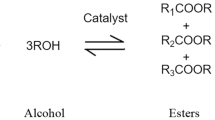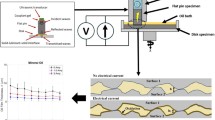Abstract
THE lubricating properties of graphite have considerable practical importance and scientific interest. The explanation often quoted for the mechanism is based on the assumption that the loosely bound graphite layers slide easily over each other like a pack of cards when graphite is used as a lubricant between moving surfaces1. In this communication we report briefly on experiments which indicate that a hitherto unconsidered mechanism might be important.
Similar content being viewed by others
References
See, for example, Bowden, F. P., and Tabor, D., “The Friction and Lubrication of Solids” (Clarendon Press, Oxford, 1950).
Bacon, R., “Growth and Perfection of Crystals”, edit. by Doremus, Roberts and Turnbull (John Wiley, 1958).
Bowden, F. P., Young, J. E., and Rowe, G., Proc. Roy. Soc., A, 212, 439 (1952). Savage, R. H., J. App. Phys., 19, 1 (1948). Carter, R. L., quoted by Hove, J. E., Trans. Met. Soc., Amer. Inst. Met. Eng., 212, 7 (1958).
Tsuzuku, T., Proc. Conf. on Carbon, 433 (Pergamon, 1957).
Author information
Authors and Affiliations
Rights and permissions
About this article
Cite this article
BOLLMANN, W., SPREADBOROUGH, J. Action of Graphite as a Lubricant. Nature 186, 29–30 (1960). https://doi.org/10.1038/186029a0
Issue Date:
DOI: https://doi.org/10.1038/186029a0
- Springer Nature Limited
This article is cited by
-
Humidity-dependent lubrication of highly loaded contacts by graphite and a structural transition to turbostratic carbon
Nature Communications (2022)
-
Frictional properties of flower stems in the plant Hippeastrum reginae (Amaryllidaceae)
Applied Physics A (2020)
-
Nano-carbons in biosensor applications: an overview of carbon nanotubes (CNTs) and fullerenes (C60)
SN Applied Sciences (2020)
-
Structural and Morphological Transformations in Aqueous Graphite-Based Lubricant Subjected to Extreme Tribological Interactions of Low-Speed Intermittent Machining
Tribology Letters (2019)
-
Highly wear-resistant and low-friction Si3N4 composites by addition of graphene nanoplatelets approaching the 2D limit
Scientific Reports (2017)





